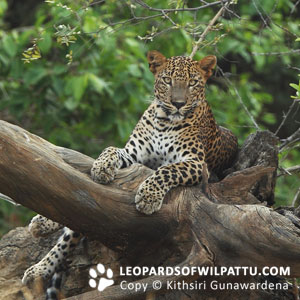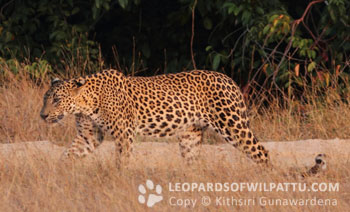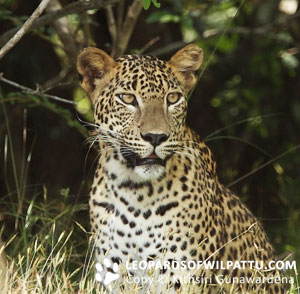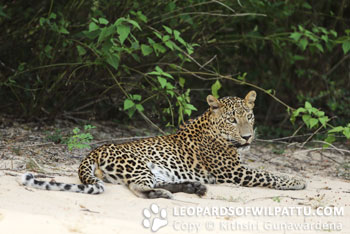
CATS IN SRI LANKA & THE SRI LANKAN LEOPARD Panthera pardus kotiya Deraniyagala, 1949
Introduction

There are 37 species of cats belonging to 14 genera, inhabiting a plethora of habitat throughout the world today. Interestingly, not a single feline species occurs naturally in Australia. Cats are not found in the Polar Regions as well. All these species subsist exclusively on a carnivorous diet. Seven of these agile hunters are considered true “big cats” on the basis of their ability to roar. These seven species are the Indochinese Clouded Leopard Neofelis nebulosa, Diard’s Clouded Leopard Neofelis diardi, Snow Leopard Panthera uncia, Tiger Panthera tigris, Leopard Panthera pardus, Lion Panthera leo and the Jaguar Panthera onca. There are many subspecies recognized of the above species as well.
The rest of the cat species including the Cheetah do not possess the ability to roar but are only able to purr. Even though scientists were of the view that a big cat’s ability to roar depended on a ligament that was found below its tongue, the latest research confirms that the main difference between the roaring big cats and the rest is found in the structure of the larynx. Long fleshy elasticated vocal folds within the larynx of big cats resonate to produce a roar whereas smaller cats including the Cheetah have simpler vocal folds that only allow purring.
Sri Lankan Cats
Four species of cats including one big cat, occur in Sri Lanka.
Rusty-spotted Cat Prionailurus rubiginosus
This is the smallest member of the cat family in terms of average weight. Adult males weigh approximately 1.5-1.6kg while the average weight of a female is 1.1kg. It is primarily a nocturnal animal. These cats are found where there is suitable habitat such as forested areas, grasslands as well as agricultural plantations such as tea, sugarcane, etc. I have seen this species in Yala, Wilpattu and Udawalawa National Parks as well as in the Sinharaja Forest Reserve.
Three subspecies are recognized with two occurring in the country and one (Prionailurus rubiginosus rubiginosus Geoffroy Saint-Hilaire, 1831) occurring in India. Of the two subspecies that occur in the Country, Prionailurus rubiginosus phillipsi Pocock, 1939, occurs in the wet zone of South-West Sri Lanka up to 2100m in humid mountain forests while the Prionailurus rubiginosus koladivinus Deraniyagala, 1956, occurs in the dry zone.
Fishing Cat Prionailurus viverrinus
This is a species which is generally associated with water but has been observed in open areas away from waterways as well. It is a nocturnal hunter that weighs between 5 to 16 kg with adult males being much larger than the females. Two subspecies are recognized in the world with one Prionailurus viverrinus viverrinus Bennett, 1833, occurring in Sri Lanka, India, South-East Asia and Sumatra and the other- Prionailurus viverrinus rizophoreus Sody, 1936, occurring in Java.
These cats are seen from sea level to the highest mountains wherever there is suitable habitat. In Sri Lanka the Fishing Cat is often found very close to human habitation even in built up areas such as Colombo and Kandy. I have seen this species at Nawala, Kandy, Morningside, Dambulla, Polonnaruwa, Muthurajawela and at the Bellanwila- Attidiya Sanctuary.
Jungle Cat Felis chaus
The Jungle Cat is about the size of a small dog and has a reddish to sandy brown to tawny grey, plain, unspotted coat. Six subspecies are recognized and they are distributed from South-East Turkey through Jordan, Egypt, Iran, Syria, the Sub-Himalayan region, India, Sri Lanka, Pakistan, Bangladesh,Vietnam, Thailand and Cambodia. As in the case of all cat species, the adult males are larger than the females and weigh between 5.7-12kg whereas the weight of the adult females is between 2.6-9kg. This species is most active during dawn and dusk.
I have seen this species in the wet zone as well as the dry zone with one record from Halgolla at an altitude of 1100m. I have recorded this species from Wasgomuwa, Bundala, Kumana and Udawalawa National Parks as well as in Bolgoda, Pamunugama, Nelundeniya, Mannar, and Elpitiya. However most of my sightings have been at Udawalawa National Park. The subspecies that occurs in Sri Lanka and South India is Felis chaus kelaarti Pocock, 1939. The specimens I have seen in the dry zone are sandy brown in colour whereas in the wet zone they are slightly darker and appear somewhat grey than brown.
Sri Lankan Leopard Panthera pardus kotiya
 Wilson, D. E. & Mittermeier, R. A eds. (2009) in Handbook of the Mammals of the World, list 24 subspecies of the Leopard currently recognized in the world including the above subspecies, which is endemic to Sri Lanka. In the IUCN Red List as well as the National Red List of 2012, the status of our leopard is categorized as endangered primarily due to continuous loss of habitat. Careful examination of photographs in similer angles will enable one to identify individual leopards in the field as their pattern of markings on the coat, head and muzzle are individually unique.
Wilson, D. E. & Mittermeier, R. A eds. (2009) in Handbook of the Mammals of the World, list 24 subspecies of the Leopard currently recognized in the world including the above subspecies, which is endemic to Sri Lanka. In the IUCN Red List as well as the National Red List of 2012, the status of our leopard is categorized as endangered primarily due to continuous loss of habitat. Careful examination of photographs in similer angles will enable one to identify individual leopards in the field as their pattern of markings on the coat, head and muzzle are individually unique.
Due to their ability to live in almost every type of habitat, as well as their ability to survive on a varied diet from rodents to herbivores twice or thrice their size, the leopard enjoys the status of being the big cat with the most extensive geographic distribution in the world. Its remarkable ability to adapt has enabled the leopard to survive even in the most inhospitable areas of the world. In Sub-Saharan Africa, leopards live in near desert habitats where the annual rainfall is as low as 50mm. Studies conducted in these areas have shown that the cat is able to survive without drinking water for as long as 10 days at a stretch. Similarly in other parts of Africa, leopards are also found in Savannahs, evergreen and deciduous forests as well as in rainforest habitats such as in Central and West Africa, where the annual rainfall is above 1500mm. Leopards inhabit all suitable habitats in the Indian subcontinent as well as in the mountainous terrain of Pakistan and Kashmir up to an altitude of about 5200m. In countries such as Thailand, Malaysia and Java, they are found in the rainforests whereas the subspecies that live in the Russian Far East inhabit mountainous forested regions where the average long-term snow cover does not exceed 15cm.
Yet another feature about this remarkable big cat is its ability to exist in close proximity to people, as long as they are not persecuted and have access to adequate den sites. In such areas the cats become extremely secretive and nocturnal and more often than not are never seen except for the pug marks and scats they leave behind.
Another interesting fact about this cat is the considerable regional variation between the subspecies in body size and weight. Adult leopards from the Cape Province of South Africa are said to be amongst the world’s smallest leopards with the average weight of a male being 30.9kg and the female being 21.2kg. However in most other subspecies including the Sri Lankan Leopard, the adult males will weigh between 50-60kgs. The subspecies, which occur closer to the equator, are generally smaller than their cousins living closer to the Polar Regions.
 In Sri Lanka, the leopard is the top predator and can be observed in its habitat during most times of the day whereas in other parts of the world such as India and Africa, it is almost exclusively nocturnal due to the presence of even larger carnivores such as the lion and the tiger. Leopards are found in most of the large national parks as well as wet zone forest reserves such as Sinharaja, Peak Wilderness and Knuckles Forest Reserve. They still occur in locations such as Hantana and other forests close to human habitations as well as in agricultural areas including tea estates adjacent to forested areas. There have been many reports of man eating leopards from India with the famed Man Eating Leopard of Panar being responsible for 400 human deaths. Fortunately in Sri Lanka such occurrences are extremely rare with the only exception being the notorious man eating leopard from Punanai in the East, which is said to have killed and devoured 12 people and was shot over its last human kill in July 1924. R. S. Agar, writing to the LORIS Vol 1 December, 1938 No.5 page 268 on the Man-eater of Punanai states “ the man-eater was not a very large leopard. He stood high off the ground, was in fine condition, and showed abnormal development for its size in respect of pads, neck muscles and head. The canine teeth were very long. He had a great number of knife wounds, old and new, showing that some of his victims had fought for their lives. As to how this leopard became a man-eater I cannot venture an opinion. Perhaps he accidentally killed a man in a state of alarm or began with a small child. I heard that his first victim was a small Moor boy, and that may possibly have been the beginning of his notorious career.”
In Sri Lanka, the leopard is the top predator and can be observed in its habitat during most times of the day whereas in other parts of the world such as India and Africa, it is almost exclusively nocturnal due to the presence of even larger carnivores such as the lion and the tiger. Leopards are found in most of the large national parks as well as wet zone forest reserves such as Sinharaja, Peak Wilderness and Knuckles Forest Reserve. They still occur in locations such as Hantana and other forests close to human habitations as well as in agricultural areas including tea estates adjacent to forested areas. There have been many reports of man eating leopards from India with the famed Man Eating Leopard of Panar being responsible for 400 human deaths. Fortunately in Sri Lanka such occurrences are extremely rare with the only exception being the notorious man eating leopard from Punanai in the East, which is said to have killed and devoured 12 people and was shot over its last human kill in July 1924. R. S. Agar, writing to the LORIS Vol 1 December, 1938 No.5 page 268 on the Man-eater of Punanai states “ the man-eater was not a very large leopard. He stood high off the ground, was in fine condition, and showed abnormal development for its size in respect of pads, neck muscles and head. The canine teeth were very long. He had a great number of knife wounds, old and new, showing that some of his victims had fought for their lives. As to how this leopard became a man-eater I cannot venture an opinion. Perhaps he accidentally killed a man in a state of alarm or began with a small child. I heard that his first victim was a small Moor boy, and that may possibly have been the beginning of his notorious career.”
I have recorded leopards in Yala, Gal-oya, Wilpattu, Wasgomuwa, Udawalawa, Minneriya, Lahugala and Horton Plains National Parks as well as forest reserves such as Ritigala, Peak Wilderness, Knuckles, Dunumadalewa – Kandy, Haldummulla, Sinharaja -Morningside and Manna watta – Athwelthota.
Melanism (where the ground colour of an animal becomes covered with a black pigment) occurs in leopards and Jaguars very much more frequently whereas it is almost non-existent in other species of big cats. Black leopards are known from several regions of Africa as well as Asia. However they are most frequently reported from the dense rainforests of Thailand, Malaysia and Java. W. W. A. Phillips in his Manual of the Mammals of Ceylon, 1935 writes of a black leopard being shot at Hambantota. Even though there have been many unconfirmed ‘claims’ of black leopard sightings by people who live close to the forests from different localities including Sinharaja Forest Reserve, Morningside as well as Horton Plains National Park no photographic evidence was available in recent history until March 2009 where a female black leopard was caught in an illegal snare in Mavuldeniya, a village off Deniyaya. This location is close to Sinharaja Forest Reserve, one of the densest rainforests in the country. Though it was unfortunate that the animal could not be saved, this find created quite an excitement among the wildlife enthusiasts in the country. Despite the many unconfirmed reports, melanistic leopards appear to be quite rare in Sri Lanka.
Even though there have been reports of leopards chasing their prey for distances of about 50meters or so, a leopard’s primary hunting strategy is to approach its prey as close as possible by stalking and launching an attack or alternatively lying and waiting in ambush to pounce on an unsuspecting animal. Even though in most of its region, leopards are known to primarily hunt at night, in Sri Lanka leopards are commonly known to hunt during day light hours as well. I once watched a female leopard at Wilpattu National Park around 7am climb a tree at great speed in pursuit of a troop of Grey Langurs. The tree that it climbed had a straight trunk of about 50-60 feet and the leopard dashed across the road as we watched and was at the top most branches almost in an instant. Even though she was not successful in making a kill, the lightning speed with which she launched the attack was quite spectacular.
 While loss of habitat is the main cause that threatens the long-term conservation of the leopard in the island, instances of poaching also appear to be on the rise with many such instances being reported in the media. There have been a number of instances where leopards have been caught in snares set for animals such as wild boar in the up country forests. It is extremely important to ensure that the national parks as well as other protected areas where the leopards occur are strictly protected to ensure the availability of habitat and prey species for the long-term survival of the species.
While loss of habitat is the main cause that threatens the long-term conservation of the leopard in the island, instances of poaching also appear to be on the rise with many such instances being reported in the media. There have been a number of instances where leopards have been caught in snares set for animals such as wild boar in the up country forests. It is extremely important to ensure that the national parks as well as other protected areas where the leopards occur are strictly protected to ensure the availability of habitat and prey species for the long-term survival of the species.
References
Wilson, D. E. & Mittermeier, R. A eds. (2009) Handbook of the Mammals of the World. Vol. 1. Carnivores. Lynx Edicions, Barcelona.
Andrew Duff and Ann Lawson (2004) MAMMALS of the WORLD A Checklist A & C Black Publishers Ltd., 37 Soho Square, London W1D 3QZ.
W. W. A. Phillips, F.Z.S., M.B.O.U. (1935) Ceylon Journal of Science MANUAL of the MAMMALS OF CEYLON
A Journal of Ceylon Wildlife -LORIS Vol 1 December, 1938 No.5 page 268. Man –eater of Punanai- R.S. Agar.